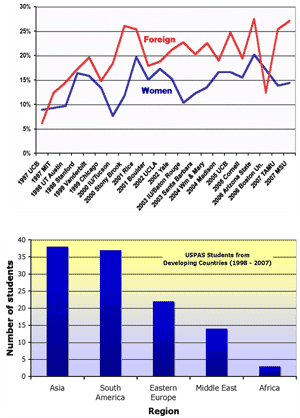The Role of the US Particle Accelerator School in International Science
By William A. Barletta, Director, United States Particle Accelerator School, and Adjunct Professor of Physics, MIT
Accelerators are essential tools for discovery in fundamental physics, biology, and chemistry. Particle beam based instruments in medicine, industry and national security constitute a multi-billion dollar per year industry. More than 55,000 peer-reviewed papers having accelerator as a keyword are available on the Web. Yet only a handful of universities offer any formal training in accelerator science.
The United States Particle Accelerator School (USPAS) is National Graduate Educational Program that has developed an educational paradigm that, over the past twenty-years, has granted more university credit in accelerator / beam science and technology than any university in the world. The USPAS Director selects highly qualified instructors from university faculty members and senior researchers from national laboratories and industry drawing on their practical experience in specific technical fields.
Governed and supported by a consortium of nine DOE laboratories and two NSF university laboratories, USPAS offers a balanced curriculum of science, engineering and hands-on courses at the graduate level. Our sessions, held twice annually in January and in June, are hosted by top US research universities that approve course content, certify the USPAS faculty, and grant course credit. The courses run 10 days in duration. Students may register for one full course (at least 45 contact hours) or they may choose two half-courses (at least 23 contact hours each) where each half-course is one-week in duration. By successfully completing the course requirements that include lectures, daily problem solving and examinations, students can earn university credit. A full-course earns three semester hours of host university credit; each half-course earns 1.5 semester credit-hours.
The USPAS has attracted more than 4200 attendees (2850 individuals) in its 36 academic sessions since the first such program at the University of Chicago in 1987. Originally serving as a continuing education program for employees of and students at our sponsoring institutions, the USPAS now boasts a student population consisting of ~ 60% graduate and post-graduate students from universities around the world. Of the approximately 120 - 140 students who attend each session, roughly two-thirds enroll for university credit.
Graduate and undergraduate students in university degree programs who take our classes for credit generally qualify for financial assistance from the USPAS at its semi-annual programs. A USPAS scholarship covers the registration fee, books, shared housing and 2 meals per day during the program. While international students without a student visa cannot receive formal credit, they are also eligible for scholarship support on the recommendation of their advisor as long as they agree to complete the same homework and exams as for-credit students.

A notable dip in attendance by international students in 2006 was due to difficulties in their obtaining visas to enter the US. Happily, this situation seems to be improving as few students were denied visas in 2007. The USPAS is pleased to have a sizable participation by students from developing countries. At present the participation by Asian and South American students is strong. To boost the attendance by students from other regions we are seeking to cooperate with professional societies (such as the APS) and research institutes to secure travel support for prospective students. Once the student is selected for travel support USPAS will agree to scholarship support of the student. Our first success along this line is an arrangement with organizers of the African light source initiative for five South African students to attend our January 2008 session devoted to synchrotron light sources and free electron lasers.
Other means of international outreach include the organization of jointly sponsored sessions in other regions. We are presently exploring the possibility of holding classes in China emphasizing the accelerator physics of spallation sources and in Brazil emphasizing synchrotron radiation sources and free electron lasers. The USPAS is dedicated to open science without borders especially in training the next generation of scientists and engineers engaged in accelerator-based science. We would welcome the collaboration of the APS in this endeavor.

